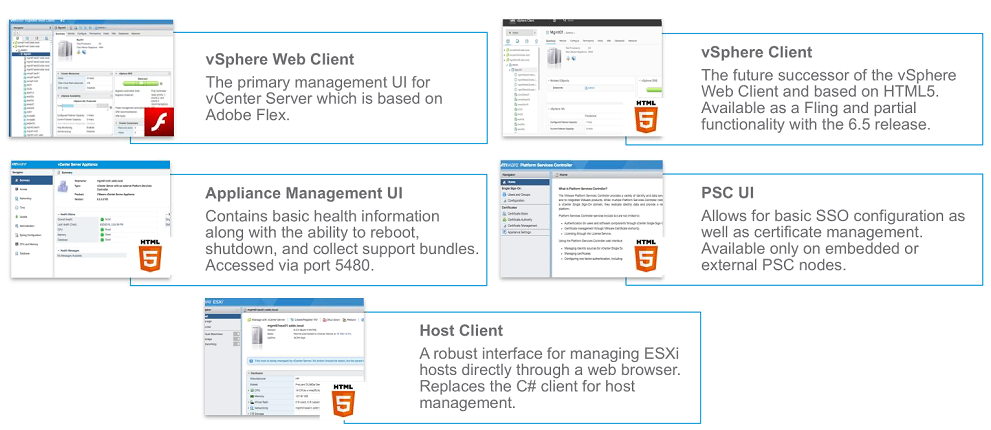
- #Use the vsphere client 6.5 how to#
- #Use the vsphere client 6.5 full#
- #Use the vsphere client 6.5 trial#
- #Use the vsphere client 6.5 windows#
In our case, we are going to create a VM on the ESXi 7 host with IP address 10.10.20.86. Once you have logged in to vCenter 7, click Hosts and Clusters, select your data center, and click the ESXi host on which you want to create a new virtual machine. You can use an administrative account or another account that has enough permissions to create virtual machines in vCenter. Click Launch vSphere Client (HTML5).Įnter your user name in the domain\username format and then enter your password. In this example the IP address of vCenter is 10.10.20.7. Open your web browser and enter the IP address of your VMware vSphere Client 7. In the example used in this article, multiple ESXi hosts are managed by VMware vCenter Server.
#Use the vsphere client 6.5 trial#
Download the free trial and try performing backups of virtual machines in your VMware vSphere environment. NAKIVO Backup & Replication is a universal data protection solution that supports VMware vSphere 7 and can back up VMs on a host level even if VMs are running in a cluster and are fault tolerant. Don’t forget about vSphere backup and data protection. One of the advantages of using virtual machines in VMware vSphere is the ease of performing backups.
#Use the vsphere client 6.5 how to#
Are there any differences between VMware vSphere 7 and previous vSphere versions when it comes to creating a new VM? This blog post explains step by step how to create a new virtual machine in VMware vSphere Client 7.0.

Creating a new virtual machine is a common action with virtualization. You can read about the new features in vSphere 7 here. VMware ESXi 7 and VMware vSphere Client 7 are the key components of this updated virtualization platform. Posted in Industry News, VMware Tagged 6.By Michael Bose How to Create a Virtual Machine Using vSphere Client 7.0

There are a lot of new features in the HTML5 VMware vSphere Client, but what I like best about vSphere Client is that VMware took the more costly and yet more customer friendly approach to creating and transitioning customers to a new user interface (and new user interface technology.) I’ve been critical of VMware in the past for some of their business and technical decisions (most notably, the fact that VMware Free ESXi doesn’t include access to the VADP (VMware API for Data Protection) interface so that backup and continuity products can protect VMware Free ESXi at the HOS (Host Operating System) level) – so I think it’s only fair to note when they do a great job focusing on customers and customer benefits.

Get a detailed look at the Unitrends Backup HTML5 user interface.
#Use the vsphere client 6.5 full#
VMware notes that the HTML5 user interface doesn’t yet have full feature parity (Unitrends HTML5 “Satori” user interface now has feature parity with its older Adobe Flex and Adobe Flash based user interface), so there are ways to access both concurrently. VMware has taken the approach that Unitrends did – to offer both user interfaces during a transition period (note: there is a third user interface, implemented in C#, which VMware is no longer shipping or supporting as of VMware vSphere 6.5.) It’s the right choice by VMware (and in my opinion, by Unitrends) because it puts customer choice first and foremost. Rip and replace lowers the cost to a vendor when upgrading user interface technology – but it is customer unfriendly and forces the user upgrading to a new release to stop and learn a new user interface in order to use the new release. The choices VMware had to make was to rip and replace its Flex and Flash-based older user interface with a new HTML5-based user interface, or to allow some type of co-existence.
#Use the vsphere client 6.5 windows#
The world is moving away from Adobe Flash – it began with Steve Jobs refusal to support Adobe Flash and has continued to date with Microsoft adding Flash Blocking features in Windows 10. VMware faced the same issue that Unitrends did in terms of its user interface when they launched VMware vSphere 6.5: its most commonly used user interface leveraged an Adobe Flex-based platform and required an Adobe Flash plugin in the browser to use.


 0 kommentar(er)
0 kommentar(er)
